Types of Cloud
Cloud computing is a revolutionary technology transforming how we store, access, and process data. It simply refers to delivering computing resources, such as servers, storage, databases, software, and applications, over the Internet. Cloud computing uses a network of remote computer systems housed on the net to save and process data rather than relying on physical infrastructure.
Cloud service companies use advanced security techniques, which include encryption, firewalls, and access restrictions, to secure your data from unauthorized access. Moreover, because your information is saved in the cloud, it is secure even if your nearby devices are damaged, misplaced, or stolen. Redundancy and cloud backups guarantee that your data may be restored promptly and effectively in case of any unexpected situations.
Types of Cloud
There are the following 5 types of cloud that you can deploy according to the organization's needs-
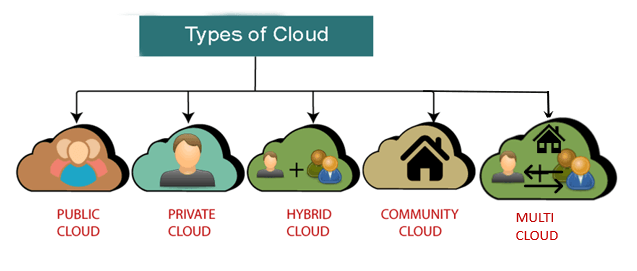
Public Cloud
Public cloud is open to all to store and access information via the Internet using the pay-per-usage method.
In public cloud, computing resources are managed and operated by the Cloud Service Provider (CSP). The CSP looks after the supporting infrastructure and ensures that the resources are accessible to and scalable for the users.
Due to its open architecture, anyone with an internet connection may use the public cloud, regardless of location or company size. Users can use the CSP's numerous services, store their data, and run apps. By using a pay-per-usage strategy, customers can be assured that they will only be charged for the resources they actually use, which is a smart financial choice.
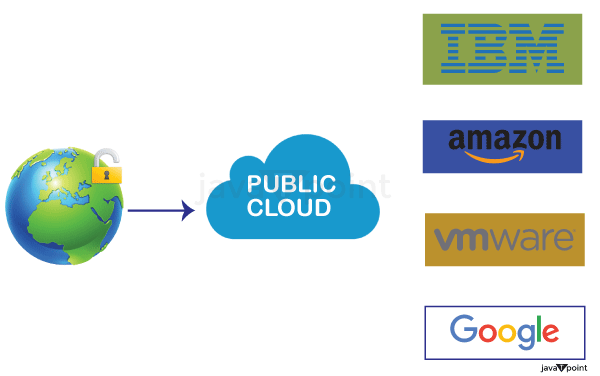
Example: Amazon elastic compute cloud (EC2), IBM SmartCloud Enterprise, Microsoft, Google App Engine, Windows Azure Services Platform.
Characteristics of Public Cloud
The public cloud has the following key characteristics:
- Accessibility: Public cloud services are available to anyone with an internet connection. Users can access their data and programs at any time and from anywhere.
- Shared Infrastructure: Several users share the infrastructure in public cloud settings. Cost reductions and effective resource use are made possible by this.
- Scalability: By using the public cloud, users can easily adjust the resources they need based on their requirements, allowing for quick scaling up or down.
- Pay-per-Usage: When using the public cloud, payment is based on usage, so users only pay for the resources they actually use. This helps optimize costs and eliminates the need for upfront investments.
- Managed by Service Providers: Cloud service providers manage and maintain public cloud infrastructure. They handle hardware maintenance, software updates, and security tasks, relieving users of these responsibilities.
- Reliability and Redundancy: Public cloud providers ensure high reliability by implementing redundant systems and multiple data centers. By doing this, the probability of losing data and experiencing service disruptions is reduced.
- Security Measures: Public cloud providers implement robust security measures to protect user data. These include encryption, access controls, and regular security audits.
Advantages of Public Cloud
There are the following advantages of Public Cloud -
- Public cloud is owned at a lower cost than the private and hybrid cloud.
- Public cloud is maintained by the cloud service provider, so do not need to worry about the maintenance.
- Public cloud is easier to integrate. Hence it offers a better flexibility approach to consumers.
- Public cloud is location independent because its services are delivered through the internet.
- Public cloud is highly scalable as per the requirement of computing resources.
- It is accessible by the general public, so there is no limit to the number of users.
- Rapid deployment of services and applications.
- Reduced time and effort in hardware procurement and setup.
- The cloud provider offers a range of services and resources that you can avail of.
- Built-in redundancy and resilience for enhanced reliability.
Disadvantages of Public Cloud
- Public Cloud is less secure because resources are shared publicly.
- Performance depends upon the high-speed internet network link to the cloud provider.
- The data is not under the control of the client.
- Dependency on the cloud service provider for availability and service level agreements.
- Compliance challenges in meeting industry-specific regulations and standards.
- Risk of vendor lock-in and limited portability of applications and data.
- Concerns about data privacy and confidentiality.
- Potential for unexpected costs with usage-based pricing models.
- Lack of customization options and flexibility compared to private or hybrid cloud environments.
- Reliance to the cloud provider's support and responsiveness for issue resolution.
To Read More Click Here
Private Cloud
Private cloud is also known as an internal cloud or corporate cloud. It is used by organizations to build and manage their own data centers internally or by the third party. It can be deployed using Opensource tools such as Openstack and Eucalyptus.
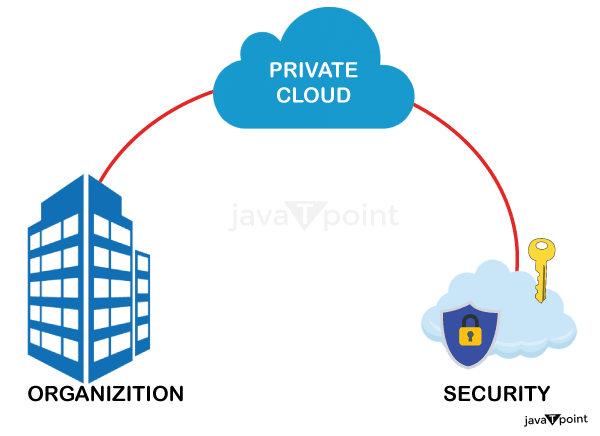
Examples: VMware vSphere, OpenStack, Microsoft Azure Stack, Oracle Cloud at Customer, and IBM Cloud Private.
Based on the location and management, National Institute of Standards and Technology (NIST) divide private cloud into the following two parts-
- On-premise private cloud: An on-premise private cloud is situated within the physical infrastructure of the organization. It involves setting up and running a specific data center that offers cloud services just for internal usage by the company. The infrastructure is still completely under the hands of the organization, which gives them the freedom to modify and set it up in any way they see fit. Organizations can successfully manage security and compliance issues with this degree of control. However, on-premise private cloud setup and management necessitate significant hardware, software, and IT knowledge expenditures.
- Outsourced private cloud: An outsourced private cloud involves partnering with a third-party service provider to host and manage the cloud infrastructure on behalf of the organization. The provider may operate the private cloud in their data center or a colocation facility. In this arrangement, the organization benefits from the expertise and resources of the service provider, alleviating the burden of infrastructure management. The outsourced private cloud model offers scalability, as the provider can adjust resources based on the organization's needs. Due to its flexibility, it is a desirable choice for businesses that desire the advantages of a private cloud deployment without the initial capital outlay and ongoing maintenance expenses involved with an on-premise implementation.
Compared to public cloud options, both on-premise and external private clouds give businesses more control over their data, apps, and security. Private clouds are particularly suitable for organizations with strict compliance requirements, sensitive data, or specialized workloads that demand high levels of customization and security.
Characteristics of Private Cloud
The private cloud has the following key characteristics:
- Exclusive Use: Private cloud is dedicated to a single organization, ensuring the resources and services are tailored to its needs. It is like having a personal cloud environment exclusively for that organization.
- Control and Security: Private cloud offers organizations higher control and security than public cloud options. Organizations have more control over data governance, access controls, and security measures.
- Customization and Flexibility: Private cloud allows organizations to customize the infrastructure according to their specific requirements. They can configure resources, networks, and storage to optimize performance and efficiency.
- Scalability and Resource Allocation: The private cloud can scale and allocate resources. According to demand, businesses may scale up or down their infrastructure, effectively using their resources.
- Performance and dependability: Private clouds give businesses more control over the infrastructure at the foundation, improving performance and dependability.
- Compliance and Regulatory Requirements: Organizations may more easily fulfill certain compliance and regulatory standards using the private cloud. It provides the freedom to put in place strong security measures, follow data residency laws, and follow industry-specific norms.
- Hybrid Cloud Integration: Private cloud can be integrated with public cloud services, forming a hybrid cloud infrastructure. This integration allows organizations to leverage the benefits of both private and public clouds.
Advantages of Private Cloud
There are the following advantages of the Private Cloud -
- Private cloud provides a high level of security and privacy to the users.
- Private cloud offers better performance with improved speed and space capacity.
- It allows the IT team to quickly allocate and deliver on-demand IT resources.
- The organization has full control over the cloud because it is managed by the organization itself. So, there is no need for the organization to depends on anybody.
- It is suitable for organizations that require a separate cloud for their personal use and data security is the first priority.
- Customizable to meet specific business needs and compliance regulations.
- Higher reliability and uptime compared to public cloud environments.
- Seamless integration with existing on-premises systems and applications.
- Better compliance and governance capabilities for industry-specific regulations.
- Enhanced flexibility in resource allocation and application deployment.
Disadvantages of Private Cloud
- Skilled people are required to manage and operate cloud services.
- Private cloud is accessible within the organization, so the area of operations is limited.
- Private cloud is not suitable for organizations that have a high user base, and organizations that do not have the prebuilt infrastructure, sufficient manpower to maintain and manage the cloud.
- Higher upfront costs and ongoing maintenance expenses.
- Scaling resources can be challenging compared to public or hybrid cloud options.
- Relies on internal IT staff for management and troubleshooting.
- Slower deployment timelines and implementation compared to public cloud solutions.
- Limited access to the latest advancements and innovations offered by public cloud providers.
- Reduced flexibility and agility compared to public cloud options.
- Challenges in keeping up with hardware and software upgrades and compatibility.
- Higher risks of technology becoming outdated and the need for regular infrastructure updates.
To Read More Click Here
Hybrid Cloud
Hybrid Cloud is a combination of the public cloud and the private cloud. we can say:
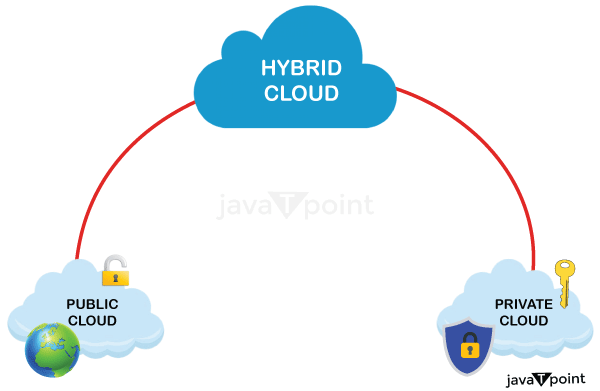
Hybrid Cloud = Public Cloud + Private Cloud
Hybrid cloud is partially secure because the services which are running on the public cloud can be accessed by anyone, while the services which are running on a private cloud can be accessed only by the organization's users. In a hybrid cloud setup, organizations can leverage the benefits of both public and private clouds to create a flexible and scalable computing environment. The public cloud portion allows using cloud services provided by third-party providers, accessible over the Internet.
Example: Google Application Suite (Gmail, Google Apps, and Google Drive), Office 365 (MS Office on the Web and One Drive), Amazon Web Services.
Characteristics of Hybrid Cloud
- Integration of Public and Private Clouds: Hybrid cloud seamlessly integrates public and private clouds, allowing organizations to leverage both advantages. It provides a unified platform where workloads and data can be deployed and managed across both environments.
- Flexibility and Scalability: Hybrid cloud offers resource allocation and scalability flexibility. Organizations can dynamically scale their infrastructure by utilizing additional resources from the public cloud while maintaining control over critical workloads on the private cloud.
- Enhanced Security and Control: Hybrid cloud allows organizations to maintain higher security and control over their sensitive data and critical applications. Private cloud components provide a secure and dedicated environment, while public cloud resources can be used for non-sensitive tasks, ensuring a balanced approach to data protection.
- Cost Optimization: Hybrid cloud enables organizations to optimize costs by utilizing the cost-effective public cloud for non-sensitive workloads while keeping mission-critical applications and data on the more cost-efficient private cloud. This approach allows for efficient resource allocation and cost management.
- Data and Application Portability: Organizations can move workloads and data between public and private clouds as needed with a hybrid cloud. This portability offers agility and the ability to adapt to changing business requirements, ensuring optimal performance and responsiveness.
- Compliance and Regulatory Compliance: Hybrid cloud helps organizations address compliance and regulatory requirements more effectively. Sensitive data and applications can be kept within the private cloud, ensuring compliance with industry-specific regulations while leveraging the public cloud for other non-sensitive operations.
- Disaster Recovery and Business Continuity: Hybrid cloud facilitates robust disaster recovery and business continuity strategies. Organizations can replicate critical data and applications between the private and public clouds, ensuring redundancy and minimizing the risk of data loss or service disruptions.
Advantages of Hybrid Cloud
There are the following advantages of Hybrid Cloud -
- Hybrid cloud is suitable for organizations that require more security than the public cloud.
- Hybrid cloud helps you to deliver new products and services more quickly.
- Hybrid cloud provides an excellent way to reduce the risk.
- Hybrid cloud offers flexible resources because of the public cloud and secure resources because of the private cloud.
- Hybrid facilitates seamless integration between on-premises infrastructure and cloud environments.
- Hybrid provides greater control over sensitive data and compliance requirements.
- Hybrid enables efficient workload distribution based on specific needs and performance requirements.
- Hybrid offers cost optimization by allowing organizations to choose the most suitable cloud platform for different workloads.
- Hybrid enhances business continuity and disaster recovery capabilities with private and public cloud resources.
- Hybrid supports hybrid cloud architecture, allowing applications and data to be deployed across multiple cloud environments based on their unique requirements.
Disadvantages of Hybrid Cloud
- In Hybrid Cloud, security feature is not as good as the private cloud.
- Managing a hybrid cloud is complex because it is difficult to manage more than one type of deployment model.
- In the hybrid cloud, the reliability of the services depends on cloud service providers.
- Potential challenges in data integration and ensuring seamless connectivity between different cloud platforms.
- Higher costs due to the need for managing and integrating multiple cloud environments.
- Increased complexity in data governance and compliance management across different cloud providers.
- Dependency on stable and high-bandwidth internet connections for efficient hybrid cloud operations.
- Potential compatibility issues between various cloud platforms and applications.
- Risk of vendor lock-in and limited portability of applications and data across different cloud providers.
- Requires skilled IT staff with expertise in managing hybrid cloud environments.
To Read More Click Here
Community cloud allows systems and services to be accessible by a group of several organizations to share the information between the organization and a specific community. It is owned, managed, and operated by one or more organizations in the community, a third party, or a combination of them.
In a community cloud setup, the participating organizations, which can be from the same industry, government sector, or any other community, collaborate to establish a shared cloud infrastructure. This infrastructure allows them to access shared services, applications, and data relevant to their community.
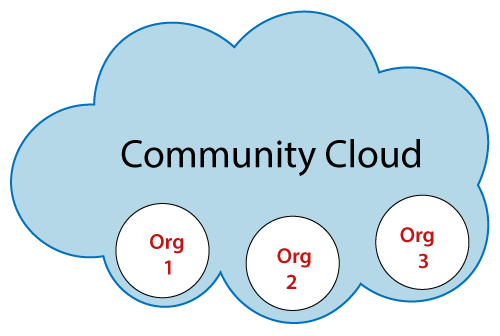
Example: Health Care community cloud
Characteristics of Community Cloud
- Shared Infrastructure: Community cloud provides a shared infrastructure accessible to a specific community of organizations. The participating organizations can leverage this common cloud infrastructure to meet their shared computing needs and objectives.
- Community-specific Services: The community cloud provides resources, apps, and services adapted to the participating organizations' demands. These services are created to meet the community's specific requirements and difficulties while promoting effective communication and information exchange.
- Community Ownership and Management: The community cloud is owned, managed, and operated by one or more organizations from the community, a third party, or a combination of both. The involved organizations have a say in the governance and decision-making procedures to ensure that the cloud infrastructure meets their shared objectives.
- Enhanced Security and Compliance: Community cloud emphasizes security and compliance measures relevant to the specific community. It allows for implementing robust security controls, access management, and compliance frameworks that meet the community's regulatory requirements and industry standards.
- Cost Sharing and Efficiency: Participating organizations in a community cloud benefit from cost sharing. By sharing the infrastructure and resources, the costs associated with establishing and maintaining the cloud environment are distributed among the community members. This leads to cost efficiency and reduced financial burden for individual organizations.
- Collaboration and Knowledge Sharing: The community cloud encourages communication and information exchange amongst participating businesses. It gives community members a forum for project collaboration, information sharing, and resource exploitation. This encourages creativity, education, and effectiveness within the neighborhood.
- Scalability and Flexibility: Community cloud enables organizations to scale up or reduce their resources in response to demand. This allows the community to adjust to shifting computing requirements and efficiently use cloud resources as needed.
Advantages of Community Cloud
There are the following advantages of Community Cloud -
- Community cloud is cost-effective because the whole cloud is being shared by several organizations or communities.
- Community cloud is suitable for organizations that want to have a collaborative cloud with more security features than the public cloud.
- It provides better security than the public cloud.
- It provdes collaborative and distributive environment.
- Community cloud allows us to share cloud resources, infrastructure, and other capabilities among various organizations.
- Offers customization options to meet the unique needs and requirements of the community.
- Simplifies compliance with industry-specific regulations and standards through shared security measures.
- Provides scalability and flexibility, allowing organizations to scale resources based on changing demands.
- Promotes efficient resource utilization, reducing wastage, and optimizing performance within the community.
- Enables organizations to leverage shared expertise and experiences, leading to improved decision-making and problem-solving.
Disadvantages of Community Cloud
- Community cloud is not a good choice for every organization.
- Security features are not as good as the private cloud.
- It is not suitable if there is no collaboration.
- The fixed amount of data storage and bandwidth is shared among all community members.
- Challenges in ensuring consistent performance and availability when multiple organizations share the same resources.
- Limited scalability options as the shared resources determine the community cloud's capacity.
- Potential conflicts of interest among community members regarding resource allocation and usage.
- Transparent governance and agreement frameworks are required to address potential disputes and ensure fair resource distribution.
- Inadequate technical support and service level agreements (SLAs) compared to private or public cloud options.
To Read More Click Here
Multi-Cloud
Multi-cloud is a strategy in cloud computing where companies utilize more than one cloud service provider or platform to meet their computing needs. It involves distributing workloads, applications, and statistics throughout numerous cloud environments consisting of public, private, and hybrid clouds.
Adopting a multi-cloud approach allows businesses to have the ability to select and leverage the most appropriate cloud services from different providers based on their specific necessities. This allows them to harness each provider's distinctive capabilities and services, mitigating the risk of relying solely on one vendor while benefiting from competitive pricing models. '
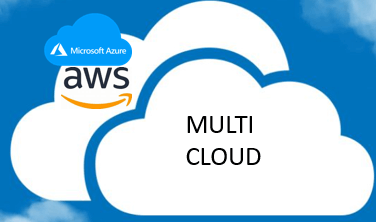
Examples: Amazon Web Services (AWS), Microsoft Azure, and Google Cloud Platform (GCP).
Characteristics of Multi-cloud
- Multiple Cloud Providers: The key characteristic of multi-cloud is the utilization of multiple cloud service providers. Organizations can leverage the offerings of different providers, such as Amazon web services (AWS), Microsoft Azure, Google Cloud Platform (GCP), and others, to access a huge range of services and capabilities.
- Diversification and Risk Reduction: Thanks to multi-cloud, organizations may distribute workloads, apps, and data across several cloud environments. This diversification decreases the danger of vendor lock-in, and the effects of any service interruptions or outages from a single cloud provider are lessened.
- Flexibility and Vendor Independence: Businesses using multi-cloud can choose the finest cloud services from various providers per their requirements. This approach enables companies to leverage each provider's unique benefits and avoids needing to depend solely on a single supplier for all their cloud computing requirements.
- Optimisation of Services and Costs: Organisations may optimize their services and costs by using a multi-cloud strategy and choosing the most affordable and appropriate cloud provider for each workload or application. They can use specialized services from many sources to meet certain demands, taking advantage of competitive pricing structures.
- Enhanced Reliability and Performance: Multi-cloud enhances reliability and performance by utilizing multiple cloud environments. By utilizing the infrastructure and resources of various providers, organizations can achieve high availability, scalability, and enhanced performance for their applications and services
- Data Sovereignty and Compliance: Multi-cloud allows organizations to address data sovereignty and compliance requirements by choosing cloud providers with data centers in specific regions or jurisdictions. It provides flexibility in managing data residency and regulatory compliance obligations.
- Interoperability and Integration: Multi-cloud necessitates interoperability and integration between different cloud platforms. Organizations must ensure seamless data exchange, application compatibility, and integration of services across the various cloud environments they utilize.
Advantages of Multi-Cloud:
There are the following advantages of multi-Cloud -
- It allows organizations to choose the most suitable cloud services from different providers based on their specific requirements.
- Distributing workloads and data across multiple cloud environments enhances reliability and ensures resilience in case of service disruptions or downtime.
- By utilizing its providers, organizations can avoid dependency on a single vendor and mitigate the risks associated with vendor lock-in.
- Organizations can optimize services and costs by selecting the most cost-effective and suitable cloud provider for each workload or application.
- Leveraging the infrastructure and resources of different cloud providers allows organizations to achieve high availability, scalability, and improved performance.
- It enables organizations to select cloud providers with data centers in specific regions, addressing data sovereignty and compliance requirements.
- Access to specialized services and capabilities from different providers promotes innovation and allows organizations to leverage the best-in-class offerings in the market.
- Distributing workloads across multiple clouds reduces the risk of data loss or service disruptions, providing enhanced disaster recovery capabilities.
Disadvantages of Multi-Cloud:
- Increased complexity in managing multiple cloud environments.
- Potential for higher costs due to multiple subscriptions and data transfer fees.
- Challenges in ensuring data governance and compliance across multiple clouds.
- Integration difficulties and compatibility issues between different cloud providers.
- Potential for increased management overhead and resource requirements.
- Risk of vendor dependencies and interoperability challenges.
Difference between public cloud, private cloud, hybrid cloud, and community cloud -
The below table shows the difference between public cloud, private cloud, hybrid cloud, and community cloud.
| Parameter |
Public Cloud |
Private Cloud |
Hybrid Cloud |
Community Cloud |
Multi-Cloud |
| Host |
Service provider |
Enterprise (Third party) |
Enterprise (Third party) |
Community (Third party) |
Multiple cloud providers |
| Users |
General public |
Selected users |
Selected users |
Community members |
Multiple organizations |
| Access |
Internet |
Internet, VPN |
Internet, VPN |
Internet, VPN |
Internet, VPN |
| Owner |
Service provider |
Enterprise |
Enterprise |
Community |
Multiple organizations |
| Cost |
Pay-per-usage |
Infrastructure investment |
Mixed (variable) |
Shared cost among members |
Variable depending on usage |
| Security |
Provider's responsibility |
Enhanced control |
Varied (depends on setup) |
Varied (depends on setup) |
Varied (depends on setup) |
| Scalability |
Highly scalable |
Scalable within resources |
Scalable within resources |
Scalable within resources |
Scalable within resources |
| Customization |
Limited control |
High control |
Varied (depends on setup) |
Varied (depends on setup) |
Varied (depends on setup) |
| Resource Sharing |
Not shared |
Not shared |
Varied (depends on setup) |
Shared among community |
Shared among providers |
|






 For Videos Join Our Youtube Channel: Join Now
For Videos Join Our Youtube Channel: Join Now










